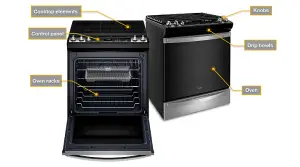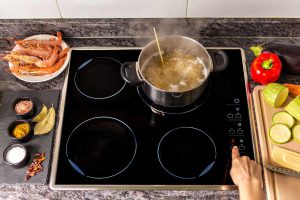Updated on March 12, 2023
The Main Parts of a Stove
Every kitchen has a stove, which is one of the most prevalent appliances in the room. Cooking on a kitchen stove is so commonplace that most individuals don’t even know where to begin. Even if your stove never breaks down, understanding what components go where may save you time and money in the long run.

The basic components of most kitchen stoves, whether gas or electric, are the same.
To help you better understand your stove, below are the names of the pieces shown in a custom diagram.
Burners
Every kitchen has a stove, which is one of the most prevalent appliances in the room. Cooking on a kitchen stove is so commonplace that most individuals don’t even know where to begin. Even if your stove never breaks down, understanding what components go where may save you time and money in the long run.
The basic components of most kitchen stoves, whether gas or electric, are the same.
To help you better understand your stove, below are the names of the pieces shown in a custom diagram.
Burner Covers
The appearance of a stove’s burners is determined by the kind of fuel it uses. Depending on the kind of stove, the burners may also take on a varied appearance. Open or sealed gas burners are available. Even the quickest sealed burners can’t match the rate of open burners.
If you’re using sealed burners, you’ll notice that food in the centre of your pot will cook quicker than food that isn’t in the middle of your pot.
Because the heat from sealed burners is distributed evenly over the bottom of the pot rather than being focused in the middle, sealed burners are less likely to cause food to burn.
A common feature of commercial kitchens is the use of open burners that come in a wide range of sizes to accommodate the many pots and pans found there. For domestic kitchens, sealed burners are popular due to their attractive appearance and aesthetic appeal.
Open burners are more common in home kitchens, whereas sealed burners are more common in commercial kitchens; the choice is yours.
Control Panel
The stove’s control panel lets you utilize and customize the stove’s many features. In addition to turning the stove on and off, the controls on a stove may also be used to adjust the temperature in the warming drawer or oven. Burner control knobs might appear on the control panel from time to time.
Drawer or Door
The warming drawers and ovens that come standard on most stoves are operated by a drawer or door mechanism.
Induction Stoves
Cooking takes place on a flat glass surface equipped with electromagnetic heating coils on induction burners. Only the iron in your cookware can turn on these heaters, which are powered by electromagnetic radiation.
On an induction burner, iron cookware that comes into contact with the active heaters causes the iron particles to swirl and rapidly heat up. When cooking on a gas or electric stove, the heat is transported from the burners to the pot or pan.

With an induction burner, just the cookware gets hot, and there’s no need to worry about the glass top being hot. As a result, induction stoves begin cooking more rapidly than gas or electric stoves since they don’t need to heat up before they can be used.
For many, the distinction between induction and electric stoves is a confusing one. While cooking, the pots and pans stay cold to the touch thanks to induction burners, which utilize electricity to heat them directly.
Instead, electric stoves use coiled metal components wrapped in a ceramic surface to heat the ceramic surface electronically to a desired temperature. Electric stoves are also stoves that acquire their heat from electricity. Induction stove components vary somewhat from those of an electric stove but are quite similar to those of a gas stove.

